Configure a Hit Policy
The Hit Policy Indicator cell displays the hit policy selected for the table. The hit policy determines the output of a decision table from the output cells of matched rules. A rule is matched when all of its condition cells match the inputs of the decision table.
-
Single Hit: A single-hit table returns the output of only one rule. Under the single-hit category, Process supports the following hit policies:
-
Unique (U) – Only one of the rules can match.
-
Any (A) – Multiple rules can match, but all matching rules must have the same output.
-
First (F) – Multiple rules can match; the output of the first rule that matches is returned.
-
Priority (P) – Multiple rules can match; the output value that has the highest priority is returned.
-
-
Multiple Hit: A multiple-hit table returns the output of multiple rules. Under this category, the following hit policies are supported in Process:
-
Collect (C) – Multiple rules can match; outputs are returned as an arbitrarily-ordered list.
-
Collect Sum (C+) – Multiple rules can match; the sum of outputs is returned.
-
Collect Min (C<) – Multiple rules can match; the smallest output value is returned.
-
Collect Max (C>) – Multiple rules can match; the largest output value is returned.
-
Collect Count (C#) – Multiple rules can match; the count is returned.
-
When you create a new table, the Unique (U) hit policy is selected by default. To change the policy, click the Hit Policy Indicator cell and choose from the available options in the Hit Policy drop-down list. If rules within the table violate the selected hit policy, a warning is displayed within the decision.
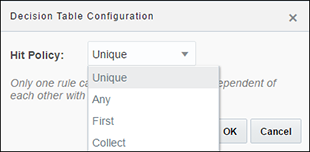
Description of the illustration dmn-hit-policy.png
Hit Policy Examples
Here are examples for all the hit policies.
-
Single Hit Unique
In a decision table with Unique hit policy, only one rule can match. All rules are independent of each other, and no overlap is permitted. The decision table returns the output of the rule that matches.
Here is a decision table created with the Unique hit policy:

Description of the illustration dmn-dt-uni.pngIn this example, for any input value of temperature, only one rule can match.
-
Single Hit Any
In a decision table with Any hit policy, multiple rules can match. The overlap is permitted only if the matching rules have the same output. The decision table returns the output of any one of the matching rules. The hit policy is breached if matching rules have different outputs.
Here is a decision table created with the Any hit policy:
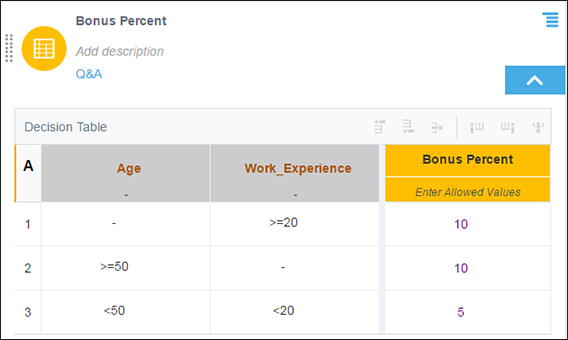
Description of the illustration dmn-dt-any.pngIn this example, for an input age of 50 and work experience of 20, the first and second rules match. This overlap is allowed because these rules have the same output. The decision table returns the output of any one of these rules.
-
Single Hit First
In a decision table with First hit policy, multiple rules with different output entries can match. The output of the lowest-numbered matching rule is the result of the table.
Here is a decision table created with the First hit policy:

Description of the illustration dmn-dt-first.pngIn this example, if service years are 11, the second and third rules match. The decision table returns only the second rule’s output.
-
Single Hit Priority
In a decision table with Priority hit policy, multiple rules with different output entries can match. The priority of output values (in descending order) is specified as a list in the Allowed Values cell of the output column. The decision table returns the output value that has the highest priority among outputs of all matching rules.
Here is a decision table created with the Priority hit policy:
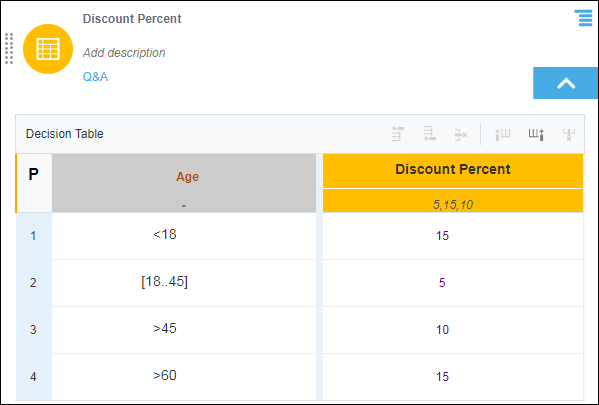
Description of the illustration dmn-dt-priority.pngIn this example, the last two rules match for an input age of 61. The decision table returns the output value that has the highest priority among of these rules, that is, 15; the priority order is defined in the Allowed Values cell.
-
Multiple Hit Collect
In a decision table with Collect hit policy, multiple rules with different output entries can match. The decision table returns outputs of all matching rules in an arbitrarily-ordered list.
Here is a decision table created with the Collect hit policy:
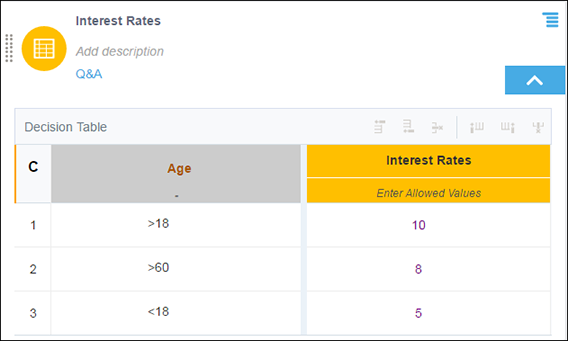
Description of the illustration dmn-dt-collect.pngIn this example, two rules match for an input age of 61. The decision table returns output values of these rules in a list:
-
Multiple Hit Collect (Sum)
In a decision table with Collect (Sum) hit policy, multiple rules with different output entries can match. The decision table returns the sum of outputs of all matching rules.
Here is a decision table created with the Collect (Sum) hit policy:
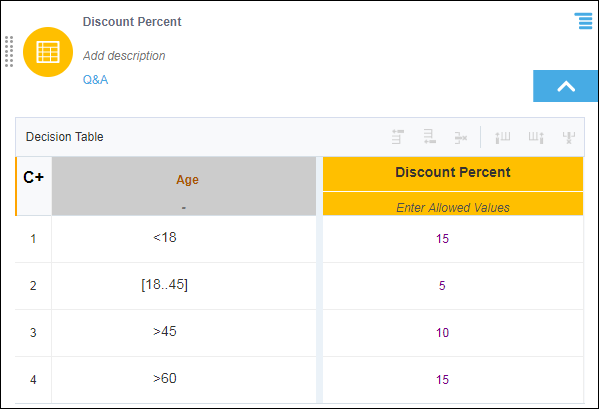
Description of the illustration dmn-dt-c1.pngIn this example, the last two rules match for an input age of 61. The decision table returns the sum of output values of these rules, that is, 25.
-
Multiple Hit Collect (Min)
In a decision table with Collect (Min) hit policy, multiple rules with different output entries can match. The decision table returns the smallest output value among all matching rules.
Here is a decision table created with the Collect (Min) hit policy:

Description of the illustration dmn-dt-cmin.pngIn this example, the last two rules match for an input age of 61. The decision table returns the smallest output value among these rules, that is, 10.
-
Multiple Hit Collect (Max)
In a decision table with Collect (Max) hit policy, multiple rules with different output entries can match. The decision table returns the largest output value among all matching rules.
Here is a decision table created with the Collect (Max) hit policy:
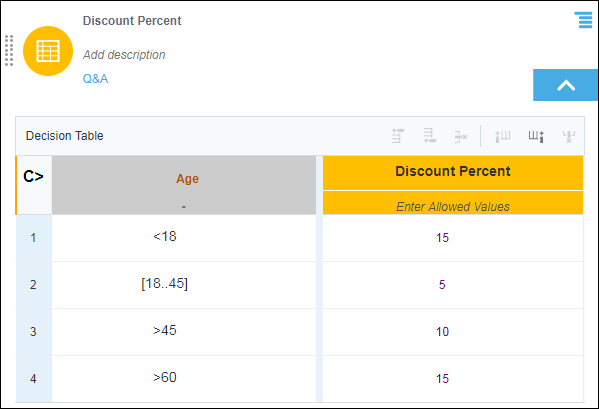
Description of the illustration dmn-dt-cmax.pngIn this example, the last two rules match for an input age of 61. The decision table returns the largest output value among these rules, that is, 15.
-
Multiple Hit Collect (Count)
In a decision table with Collect (Count) hit policy, multiple rules with different output entries can match. The decision table returns the count of matching rules.
Here is a decision table created with the Collect (Count) hit policy:
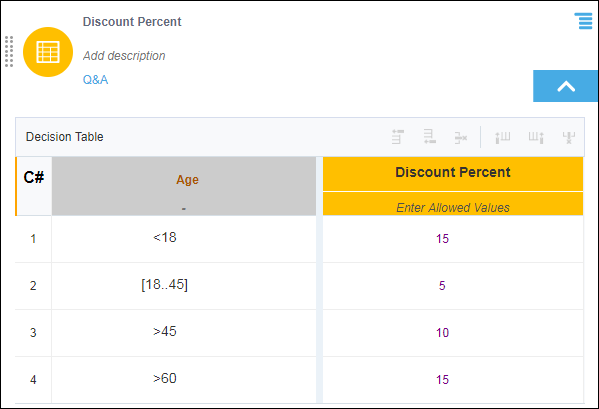
Description of the illustration dmn-dt-c.pngIn this example, the last two rules match for an input age of 61. The decision table returns the count of matching rules, that is, 2.
